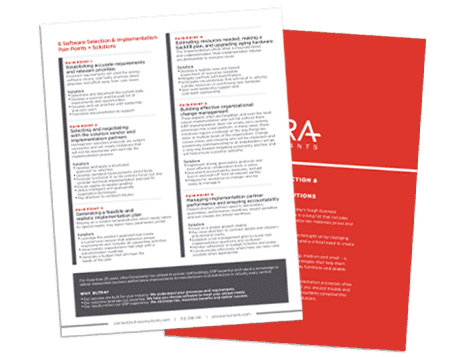Our team regularly shares Stories from the Field that highlight the value today’s organizations achieve when an organization decides to team with an independent ERP consulting firm.
Today’s stories are focused on the real-world benefits of implementing a product configurator. What follows are three stories from complex manufacturing organizations that looked to simplify the production of engineered, ordered, planned and controlled products. In each case, the project teams wanted to improve the processes to build out products that are configured uniquely for each customer order.

The efforts are part of business process improvement services we often deliver to complex manufacturing organizations.
Looking at Implementing a Product Configurator
We’ve looked at this topic in a recent blog post entitled Looking at the Challenges of Integrating the Product Configurator and ERP.
In addition, another archived post outlined the benefits of Using Product Configurator Software for Manufacturing.
In the cases outlined in this blog post, the companies were limited by legacy processes to manage the product configuration process. The companies used a variety of spreadsheets, shared documents, or even paper record-keeping, thus it became difficult to offer the most options to a customer.
This resulted in wasted steps and inefficient handling – especially when manually taking order requirements and using manual methods to control the production of the specific product with quality checks at the end to assure the product would meet the requirements.
Story One: Industrial Supplier
As an example, Ultra worked with an industrial supplier that manufactures retaining rings which are used in a variety of industrial applications.
When an order came in from a customer, the product team would design the order at a given size and then manually create 200+ versions of the ring for all the dimensions possible. The product team would have to manually take the order requirements and let engineering develop the data required to produce the specific version.
These inefficient processes slowed production, resulted in excess cost and wasted effort.
As we worked with the team, we heard many times that these inefficient processes slowed production, resulted in excess cost and wasted effort. By automating the product configuration process, the company could streamline all the steps along the way including
- Automating options order entry where customer service can select the feature the customer wants as part of the quoting or order entry process
- For calculable differences (such as bigger or smaller than standard rings), the system automatically develops a parametric processor that can re-calculate all the product dimensions based on rules in the algorithm
- Creating libraries of configurable components in the CAD system and standardizing how components fit/work together
- Forecasting the need for components to add to the configuration as opposed to trying to forecast all the end versions
As a result of Ultra’s ERP process improvement services, the company gained value from better flexibility, faster time to production, and improved accuracy of the uniquely configured products.
Automating the process let the product team keep the focus on the customers and their needs, giving the customer what they want rather than what they can get based on what is available.
Story Two: Furniture Producer
A second “story from the field” comes from a manufacturer of RV furniture. The Ultra team worked with this company and once again, saw that implementing a product configurator was the smart approach to improve processes.
When orders come into the company, there are no production standards in place for dimensions since most RV interiors are custom designed. Each piece of furniture is re-calculated based on the space available per the RV design.
Manually setting up a base version of each product was simply not scalable. Thus, the ERP project team set up a parametric processor to re-compute all of the elements of the furniture to supply the desired product with all of the required structural elements without having to re-engineer each order.
With the automated solution, staff can choose options at quoting/order entry to allow for various fabrics, accessories, fabric treatments, and other configurations as desired by the customer without engineering assistance while properly pricing the order.
This allows the company to deliver a customer-specific version of each piece of furniture on time with a cost effective price. The result is customer orders with all the accessories defined and internal data defined in the system (Item Master, BOM, Routing, costing, order, etc.). In addition, manufacturing coordinated all the items for the order so that all the furniture was delivered together.
So for this company, implementing a product configurator improved the ability to automatically create and manage complex product configurations and associated process definitions.
Story Three: Storage Equipment Manufacturer
The final “story from the field” also illustrates the benefits of implementing a product configurator.
Our team worked with a manufacturer of pallet storage racks. These items are typically seen in the bulk storage areas or retail back rooms of big box retail stores, as well as in manufacturing warehouses.
Customers will order the applet storage racks to fit a variety of sizes and environments. Each order is customized with a unique length, depth, and height of storage. Producing pallets requires a focus on structural integrity since these racks will be holding a significant amount of weight.
Instead of manually tracking product configuration, ordering, and production requirements, we helped streamline the configuration process.
A parametric processor is now used to provide the dimensions of product required by the customer while maintaining all the structural elements required. Elements determined in the algorithms include gauge of steel to be used, the number of cross braces required, the number of brackets to be used and other requirements. By automating the process, the production team can customize each order to be specific to the customers’ needs without having to engineer each specific order.
Thinking about Implementing a Product Configurator? Learn More
As you consider your own requirements for implementing a product configurator, take a moment to download the paper “ERP Maturity and Health: Is Your Business at Risk with Your Legacy System?”
Concerned about the health of your product configuration processes? Contact Ultra for the best path forward.
6 Software Selection & Implementation Pain Points + Solutions
Software selection and implementation processes often present challenges of their own. To steer you around trouble and help you drive success, Ultra’s experts compiled a list of pain points and solutions to be aware of as you embark on this journey.

Table of Contents
More ERP material...
AI in Food and Beverage Manufacturing
Discover how AI is revolutionizing food and beverage manufacturing, enhancing quality, reducing…
How ERP for Quality Control Eliminates Manual Documentation Chaos
This post will examine why managing quality records outside of an ERP…
Assessing Your AI Maturity
This article breaks down how businesses can measure their AI maturity to…



